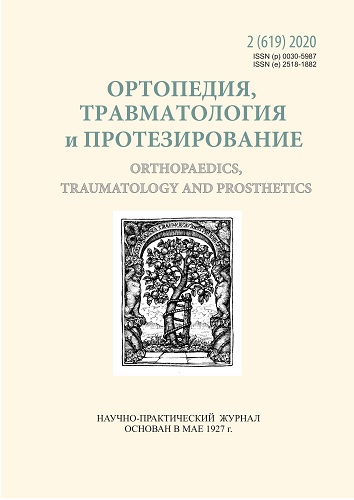Device for bone chips filtration
DOI:
https://doi.org/10.15674/0030-59872020275-79Keywords:
reamer, grafting, device, spine fusion, chips, bone graftAbstract
Application of grafts for bone grafting is essential for spine surgery, traumatology and orthopedics, oncology, maxillofacial surgery. However, there is no ideal graft that would have all the necessary properties (osteogenic, osteoconductive, osteoinductive) and it would not have significant disadvantages. At spinal surgery, high-speed bone milling machines are used during decompression. In the case of bone tissue resection an equivalent amount of bone chips appears which is routinely aspirated and disposed of together with blood and destroyed tissues. At the same time at bone grafting there is a shortage of local graft material. Objective: to acquaint readers with the possibility of obtaining bone grafts with the help of the developed device as a high-speed bone surgical reamer during spinal fusion. Methods: a device for filtering bone chips is created, consisting of a flask and a filter element inside it, connected in parallel to the aspiration system. The device allows preserving a sufficient amount of bone-grafting material, which consists of bone tissue elements, fibrin clot, bone marrow cells, platelets, mesenchymal stromal cells and others. Results: a clinical example of its application at transforaminal interbody fusion at the level of the lumbar segment LIV–LV is presented. The device differs favorably from the known ease of assembly, reusability (possibility of repeated sterilization) and placement on the operating table. Conclusions: the application of a bone filter is appropriate in the case of spine decompression of a high-speed bone reamer, when the stage of surgery is bone grafting. Do not use the device in case of spine tumors, spondylitis, spondylodiscitis.References
- Voronovich, I. R. (2004). State of Surgical Vertebrology in Belarus and its achievements. Spinal Surgery, 1, 33-38. [in Russian]
- Maxurenko, A. N., & Kosmacheva, S. M. (2012). The biological basis of spinal fusion lumbar spine and materials for it the implementation. Medical News, 7, 22-26. [in Russian]
- Voronovich, I. R., Pashkevich, L. A., & Golutvina, N. O. (2007). Diagnostics and technologies of safe operations at tumors and tumor-like diseases of the knee the joint. Ministry of Health of the Republic Belarus, Republican Scientific and Practical Center traumatology and orthopedics. Minsk. [in Russian]
- Kirilova, I. A. (2011). Bone tissue as the basis of osteoplastic materials for bone structure restoration. Spinal Surgery, 1, 68-74. [in Russian]
- Roberts, T. T., & Rosenbaum, A. J. (2012). Bone grafts, bone substitutes and orthobiologics. Organogenesis, 8(4), 114-124. doi: 10.4161/org.23306
- Boltrukevich, S. I., & Ivantsov, V. A. (1997). Alloplasty demineralized bone matrix in reconstructive surgery of the musculoskeletal system. Healthcare, 4, 4-6. [in Russian]
- Carreira, A. C., Alves, G. G., Zambuzzi, W. F., Sogayar, M. C., & Granjeiro, J. M. (2014). Bone morphogenetic proteins: Structure, biological function and therapeutic applications. Archives of Biochemistry and Biophysics, 561, 64-73. doi: 10.1016/j.abb.2014.07.011
- Oikarinen, J., & Korhonen, L. K. (1979). The bone inductive capacity of various bone transplanting materials used for treatment of experimental bone defects. Clinical Orthopaedics and Related Research, 140, 208-215. doi: 10.1097/00003086-197905000-00039
- Banwart, J. C., Asher, M. A., & Hassanein, R. S. (1995). Iliac crest bone graft harvest donor site morbidity. Spine, 20(9), 1055-1060. doi: 10.1097/00007632-199505000-00012
- Ardashev, I. P., Grigoruk, A. A., & Plotnikov, G. A. (1999). Possible complications after taking an autograft from the iliac wing. Modern Technologies in TRAUMATOLOGY and orthopedics, 191-192. [in Russian]
- Muschler, G. F., Boehm, C., & Easley, K. (1997). Aspiration to obtain osteoblast progenitor cells from human bone marrow. The Journal of Bone and Joint Surgery. American Volume, 79(11), 1699-1709. doi: 10.2106/00004623-199711000-00012
- Ekanayake, J., & Shad, A. (2009). Use of the novel Anspach bone collector for bone autograft in anterior cervical discectomy and cage fusion. Acta Neurochirurgica, 152(4), 651-653. doi: 10.1007/s00701-009-0513-0
- Patel, V. V., Estes, S. M., Naar, E. M., Lindley, E. M., & Burger, E. (2009). Histologic evaluation of high speed burr shavings collected during spinal decompression surgery. Orthopedics, 32(1), 23-5. doi: 10.3928/01477447-20090101-17
- Eder, C., Chavanne, A., Meissner, J., Bretschneider, W., Tuschel, A., Becker, P., & Ogon, M. (2011). Autografts for spinal fusion: osteogenic potential of laminectomy bone chips and bone shavings collected via high speed drill. European Spine Journal, 20(11), 1791-1795. doi: 10.1007/s00586-011-1736-3
- Lisak, P., Young, L., & Atrion Medical Products Inc. (1998). Autogenous bone speciemen collector. USA. Patent US5766134A
- Ashman, A., Ashman, A., & Enterprises Inc. (2001). Autogenous bone and cell filter trap. USA. Patent US6299763B1
- Rozhin, V. V., Kirilenko, S. I., & Krivenchuk, V. A. (2017). Device for bone chip filtration. Belarus. Patent 11383. [in Russian]
Downloads
How to Cite
Issue
Section
License
Copyright (c) 2020 Sergei Kirilenko, Vladimir Rozhin, Eldar Nadyrov, Vladimir Nikolaev, Andrei Mazurenko, Artem Dobysh

This work is licensed under a Creative Commons Attribution 4.0 International License.
The authors retain the right of authorship of their manuscript and pass the journal the right of the first publication of this article, which automatically become available from the date of publication under the terms of Creative Commons Attribution License, which allows others to freely distribute the published manuscript with mandatory linking to authors of the original research and the first publication of this one in this journal.
Authors have the right to enter into a separate supplemental agreement on the additional non-exclusive distribution of manuscript in the form in which it was published by the journal (i.e. to put work in electronic storage of an institution or publish as a part of the book) while maintaining the reference to the first publication of the manuscript in this journal.
The editorial policy of the journal allows authors and encourages manuscript accommodation online (i.e. in storage of an institution or on the personal websites) as before submission of the manuscript to the editorial office, and during its editorial processing because it contributes to productive scientific discussion and positively affects the efficiency and dynamics of the published manuscript citation (see The Effect of Open Access).














